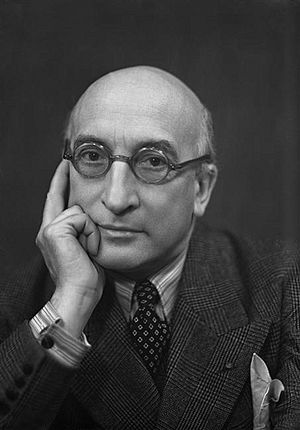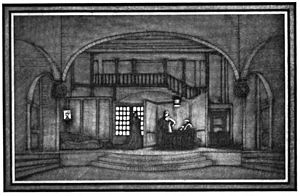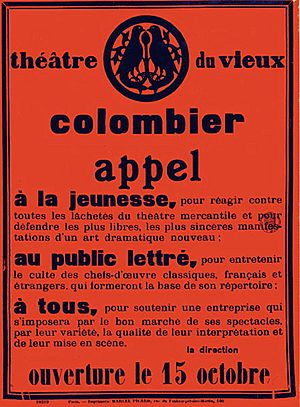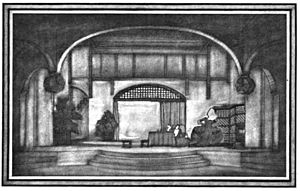Jacques Copeau facts for kids
Quick facts for kids
Jacques Copeau
|
|
|---|---|

Jacques Copeau, 1936
|
|
| Born | 4 February 1879 Paris, France
|
| Died | 20 October 1949 (aged 70) |
| Occupation | Director, producer, actor, and dramatist |
Jacques Copeau (born February 4, 1879 – died October 20, 1949) was a famous French theater director, producer, actor, and writer. He changed French theater a lot in the 20th century. The famous writer Albert Camus once said that French theater has two main parts: before Copeau and after Copeau.
Before he started his own theater, the Théâtre du Vieux-Colombier in Paris, Copeau wrote about plays for different magazines. He also worked at an art gallery, helping to set up art shows. In 1909, he helped create a new magazine called Nouvelle Revue Française with his friends, including André Gide.
Contents
Who was Jacques Copeau?
Jacques Copeau grew up in a wealthy family in Paris, France. He went to the best schools, like the Lycée Condorcet. Even though he was smart, he cared more about theater than his schoolwork.
His first play, Brouillard du matin (meaning "Morning Fog"), was performed in 1897. Important people, like a former French president, liked his play.
Around this time, Copeau met Agnès Thomsen, a young woman from Denmark. He was 17 and fell in love with her.
Copeau went to the Sorbonne to study philosophy. But he spent most of his time reading, going to the theater, and seeing Agnès. He didn't pass his exams. In 1902, he married Agnès in Copenhagen. They had two daughters, Marie-Hélène and Hedwig.
In 1903, Copeau and his family moved back to France. He worked at his family's factory. He also became a well-known theater critic, writing reviews for many publications. He wrote about plays like Ibsen's A Doll's House.
In 1905, he started working at the Georges Petit Gallery, organizing art shows. He kept writing theater reviews and became known for his smart and honest opinions. When his family's factory was sold, he had enough money to focus on his writing. He was also one of the people who started the Nouvelle Revue Française (NRF), a very important magazine in France.
In 1910, Copeau bought a country house called Le Limon. He worked hard there to adapt Dostoyevsky's book The Brothers Karamazov into a play. He finished it by the end of 1910. He was now ready to work in theater, not just write about it.
The play was performed in April 1911 and got good reviews. Charles Dullin and Louis Jouvet, who would later become important in Copeau's theater, were in the play.
Starting the Théâtre du Vieux-Colombier
Copeau had a big idea to make French theater better. He wanted to get rid of the overly commercial plays and bad acting that were common in Paris. He felt that even famous theaters like the Comédie-Française had become too artificial. He wanted theater to be simpler and focus on the play's true meaning.
With his ideas, his position at the NRF, and the support of friends, Copeau decided to start his own theater company. He rented an old building on the rue du Vieux-Colombier, on the Left Bank of Paris. He chose this spot because it was far from the commercial theaters. He named it the Théâtre du Vieux-Colombier, after the street.
In the spring of 1913, Copeau began putting together his acting group. He hired Charles Dullin, Louis Jouvet (who also managed the stage), Roger Karl, and Suzanne Bing.
That summer, Copeau took his actors to his country house, Le Limon. In September 1913, he published an essay called Un essai de rénovation Dramatique: le théâtre du Vieux-Colombier. In it, he explained his theater's goals:
- Location: Far from the busy commercial area, closer to schools and artists. This would attract students and thinkers.
- Variety: Many different plays each week. This would help actors practice different roles.
- Repertoire: A mix of classic plays by writers like Jean Racine and Molière, and new plays by modern writers. He wanted to encourage new playwrights.
- Acting: He hated "ham acting" (over-the-top acting). He wanted a new, honest style.
- School: He planned to open a school for young actors to train them properly.
- Simple Stage: He wanted a bare stage, without lots of fancy scenery. He said, "For our new undertaking, just give us a bare platform."
In October, posters appeared in Paris, asking young people and art lovers to support his new theater. The "Old Dove-cote" theater was ready to open.
In its first season, Copeau kept his promises. He staged classics, newer quality plays, and works by new writers. The Théâtre du Vieux-Colombier opened on October 22, 1913. Some plays, like Molière's Amour médecin, were well-received. Charles Dullin was praised for his role as Harpagon in Molière's L’Avare. The company also performed Paul Claudel's L’Échange and a popular version of The Brothers Karamazov.
The season ended with Shakespeare's Twelfth Night (or Nuit des rois). This play became famous for its simple stage and imaginative style. Audiences loved it, and it showed how talented the young actors were.
Theater During World War I
Planning for the next season stopped when World War I began in August 1914. Many actors, including Copeau, were called to serve in the military. The theater had to close.
Copeau kept writing to Jouvet and Dullin about theater ideas. They thought about a "new comedy" style, like the Italian commedia dell'arte. This led to the idea of a "unit set," a simple stage design that could be used for many different plays.
In 1915, Copeau visited Edward Gordon Craig in Florence. Craig was another important theater reformer. They discussed ideas, though they didn't always agree. Craig believed actor training was key, but he doubted it was possible. He even thought about using "super-marionnettes" instead of human actors.
On his way back, Copeau stopped in Geneva. He met Adolphe Appia, a stage designer, and Émile Jaques-Dalcroze, who taught rhythmic movement. Copeau saw that Dalcroze's methods could help train young actors in movement. He and Suzanne Bing started using these methods to train young people in Paris.
In 1916, Copeau was invited to tour America with the Vieux-Colombier. This was partly to show French culture and gain American support during the war. Copeau hoped to bring his actors back from the war, but he couldn't. So, he went to the United States alone in January 1917 to give lectures.
In New York City
When Copeau arrived in New York, the newspapers praised him. Otto H. Kahn, a rich supporter of the arts, was very impressed by Copeau. In February 1917, Kahn offered Copeau the chance to direct a French theater in New York.
Copeau chose the Garrick Theatre because he felt it could be changed to fit his simple unit set idea. He hired a young architect, Antonin Raymond, to help with the renovations. Copeau also gave many lectures about theater art and stage design.
In May 1917, Copeau got a good contract and money to prepare for the New York season. He returned to Paris to choose plays, get costumes, and gather his actors. Jouvet was allowed to leave the war, but Dullin could not.
Jouvet built a model of the stage for the Garrick Theatre. In New York, Antonin Raymond worked hard on the renovations. With help from Kahn, the old Garrick Theatre began to look ready. Jouvet arrived in October to oversee the final stage preparations.
On November 26, 1917, the Théâtre du Vieux-Colombier de New York opened. The first play was Impromptu du Vieux-Colombier, written by Copeau, and Molière's Les Fourberies de Scapin. The stage was bare, just as Copeau wanted. This allowed actors to move freely, which critics noticed and liked.
During the first season, the Vieux-Colombier in New York performed 21 different plays. Many were from their first season in Paris, like Molière's L'Avare and Shakespeare's Twelfth Night. They also performed new plays. It was a mix of classic and modern works. After New York, the troupe toured to Washington, D.C., and Philadelphia.
Some plays were very popular, like The Brothers Karamazov and Twelfth Night. Dullin, who finally arrived in March 1918, was excellent in his roles.
In May, the actors went to Otto Kahn's estate in Morristown, New Jersey, to prepare for the next season. Copeau made them work very hard with rehearsals and exercises. The actors were tired, and there were worries about illness.
The second season opened with a play that had already been on Broadway. Copeau realized he needed to offer some popular plays to make money. But he also kept his high standards. Pierre Beaumarchais's Le Mariage de Figaro was a big success. Henrik Ibsen's Rosmersholm was also well-received.
Copeau thought Maurice Maeterlinck's Pelléas et Mélisande was the best play of the season. The simple stage, clever lighting, and banners allowed the story to flow smoothly. The season ended with an Impromptu, where actors showed off their best roles.
Before Copeau went back to Europe, critics praised his work. One critic wrote that the Vieux-Colombier had given New York "a continually varied feast of inspiration" and set a new standard for American theater.
The Paris Years: 1920–1924
When Copeau returned to Paris, he needed to rest. But he also had important tasks. He finished adapting The Winter's Tale, which would be the first play when the theater reopened in January 1920. He and Jouvet also oversaw renovations to the stage and lighting at the Vieux-Colombier. They installed a new lighting system.
Copeau believed that a school for dramatic arts was essential to his dream of renewing theater.
The theater reopened on February 9, 1920, with The Winter's Tale. The simple stage with bare gray walls surprised some critics. But other plays, like Le Paquebot Tenacity and Le Carrosse du Saint-Sacrement, were popular. The company performed works by new writers, showing their strong acting skills.
By the end of February, auditions were held for the "Classes at the Vieux-Colombier." Suzanne Bing organized these classes. Students worked on reading texts, understanding rhythms, and doing physical exercises.
Even though the theater was an artistic success, it was in debt. The stage was smaller, making it harder to make money. Copeau asked his friends for help. The school also needed more space.
The 1920/1921 season started with popular plays from earlier seasons. Audiences liked the classic plays directed by Copeau. Critics wondered when new plays would be shown.
The best part of the 1921/1922 season was the opening of the School of the Vieux-Colombier. It was in a building near the theater. Courses began in November. Copeau taught about theater theory and Greek tragedy. Jouvet taught about Greek theater architecture. Suzanne Bing taught reading and speaking. Copeau's daughter, Marie-Hélène, led a workshop on design and costumes.
The Vieux-Colombier became very famous in the 1922-23 season. Every show was sold out. Visitors to Paris found it hard to get tickets. Copeau organized tours to other parts of France. Other countries invited them to perform. When Konstantin Stanislavski, a famous Russian theater director, visited Paris, he was welcomed at the Vieux-Colombier. Copeau's ideas influenced theater across Europe and the United States.
However, problems started. Jouvet understood the theater's finances better than Copeau. He thought they needed a bigger theater and better ticket prices. Copeau didn't agree. Jouvet decided to leave and direct at another theater. Other members also left.
Despite these issues, the school continued to do well. Copeau's students appeared in a play called Saül. Critics liked their performance. But the theater still ended the season in debt.
By the 1923/24 season, the Vieux-Colombier faced competition from former members like Jouvet and Dullin. Copeau's theater lost some of its audience. Two important events for Copeau were the staging of his own play, La Maison natale, and the Noh play Kantan.
La Maison natale was a play Copeau had worked on for over 20 years. It was about a father and his sons. The play didn't get great reviews, which upset Copeau. But Kantan, performed by his students, was a big success. It showed how well the young actors had been trained.
At the end of the season, the troupe toured France, Belgium, and Switzerland. Then, Copeau made a huge decision: he closed the Théâtre du Vieux-Colombier. He couldn't make money and was tired of asking friends for help. He wanted to be independent. So, he moved to the Burgundy countryside with some of his actors and students to start a new project.
The Burgundy Adventure: The "Copiaus"
In October 1924, Copeau and his young actors moved to a village in Burgundy. They called their new home the "Château de Morteuil" (Castle of Morteuil). Copeau tried to restart his school there. But he didn't have much money, so he had to give many lectures to pay for things.
He tried to get financial support by performing two plays for some business people. He wanted to perform only four plays a year, with eight months of practice and four months of shows. But he didn't get the money he needed.
After some students and teachers left, Copeau worked with a smaller group on a "New Comedy." This was an attempt to recreate the Italian commedia dell'arte with masks and improvisation. He wrote a play called Le Veuf (The Widower). The actors rehearsed it on a simple stage. The people in the nearby villages called the actors les Copiaus, after Copeau.
Starting in May 1925, the Copiaus performed Molière's plays and new plays written by Copeau. They used their own handmade masks. Before each show, the whole group would parade through the village with drums, horns, and colorful banners. They performed on bare stages in village squares or any indoor space they could find.
Copeau continued to work with the Copiaus, even with his busy schedule of lectures. The Copiaus became very creative.
At the end of the year, the troupe moved to Pernand-Vergelesses, a village in Burgundy's wine region. Copeau had bought a house there that was better for his family and the Copiaus. From here, the Copiaus took their shows to many towns in Burgundy and to Switzerland, Belgium, the Netherlands, and Italy. Copeau also continued his lectures to support himself and the troupe. In 1926, he went to the United States to lecture and direct The Brothers Karamazov in English.
In June 1929, the Copiaus formed a new group called La Compagnie des Quinze. It was led by Michel Saint-Denis. They returned to Paris and performed a play called Noé (Noah). From this point on, Copeau's direct control over the group ended, but his influence on them remained strong.
Later Life and Legacy
In 1933, Copeau directed a play called The Mystery of Saint Uliva in Florence. In 1935, he directed Savonarola. In Paris, he directed Shakespeare's Much Ado About Nothing and Molière's Le Misanthrope at the Comédie-Française in 1936. He continued to direct plays there in 1937 and 1938.
In 1940, Copeau became the temporary leader of the Comédie-Française. He staged plays like Pierre Corneille's Le Cid and Shakespeare's Twelfth Night. But he refused to follow orders from the German occupiers, so he resigned in March 1941. He went back to his home in Pernand-Vergelesses.
His own play, Le Miracle du pain doré ("The Miracle of the Golden Bread"), was performed in 1943. The next year, his play about Saint Francis of Assisi, Le Petit Pauvre (The Poor Little One), was published.
Death
Jacques Copeau died on October 20, 1949. He and his wife are buried in the church graveyard in Pernand-Vergelesses.
Images for kids
See also
 In Spanish: Jacques Copeau para niños
In Spanish: Jacques Copeau para niños








